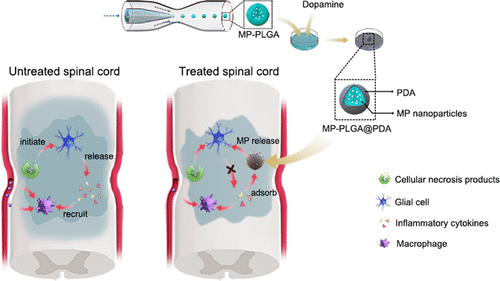当前位置:
X-MOL 学术
›
ACS Appl. Mater. Interfaces
›
论文详情
Our official English website, www.x-mol.net, welcomes your
feedback! (Note: you will need to create a separate account there.)
Polydopamine-Decorated Microcomposites Promote Functional Recovery of an Injured Spinal Cord by Inhibiting Neuroinflammation
ACS Applied Materials & Interfaces ( IF 8.3 ) Pub Date : 2021-10-01 , DOI: 10.1021/acsami.1c11772 Guangfei Wei 1, 2 , Dongdong Jiang 3 , Shuai Hu 1, 2 , Zhiyuan Yang 1, 2 , Zifan Zhang 1, 2 , Wei Li 4 , Weihua Cai 3 , Dongfei Liu 1, 2
ACS Applied Materials & Interfaces ( IF 8.3 ) Pub Date : 2021-10-01 , DOI: 10.1021/acsami.1c11772 Guangfei Wei 1, 2 , Dongdong Jiang 3 , Shuai Hu 1, 2 , Zhiyuan Yang 1, 2 , Zifan Zhang 1, 2 , Wei Li 4 , Weihua Cai 3 , Dongfei Liu 1, 2
Affiliation

|
Neuroinflammation following spinal cord injury usually aggravates spinal cord damage. Many inflammatory cytokines are key players in neuroinflammation. Owing largely to the multiplicity of cytokine targets and the complexity of cytokine interactions, it is insufficient to suppress spinal cord damage progression by regulating only one or a few cytokines. Herein, we propose a two-pronged strategy to simultaneously capture the released cytokines and inhibit the synthesis of new ones in a broad-spectrum manner. To achieve this strategy, we designed a core/shell-structured microcomposite, which was composed of a methylprednisolone-incorporated polymer inner core and a biocompatible polydopamine outer shell. Thanks to the inherent adhesive nature of polydopamine, the obtained microcomposite (MP-PLGA@PDA) efficiently neutralized the excessive cytokines in a broad-spectrum manner within 1 day after spinal cord injury. Meanwhile, the controlled release of immunosuppressive methylprednisolone reduced the secretion of new inflammatory cytokines. Benefiting from its efficient and broad-spectrum capability in reducing the level of cytokines, this core/shell-structured microcomposite suppressed the recruitment of macrophages and protected the injured spinal cord, leading to an improved recovery of motor function. Overall, the designed microcomposite successfully achieved the two-pronged strategy in cytokine neutralization, providing an alternative approach to inhibit neuroinflammation in the injured spinal cord.
中文翻译:

聚多巴胺修饰的微复合材料通过抑制神经炎症促进受损脊髓的功能恢复
脊髓损伤后的神经炎症通常会加重脊髓损伤。许多炎症细胞因子是神经炎症的关键参与者。主要由于细胞因子靶点的多样性和细胞因子相互作用的复杂性,仅通过调节一种或几种细胞因子不足以抑制脊髓损伤进展。在此,我们提出了一种双管齐下的策略,以同时捕获释放的细胞因子并以广谱方式抑制新细胞因子的合成。为了实现这一策略,我们设计了一种核/壳结构的微复合材料,它由掺入甲泼尼龙的聚合物内核和生物相容性聚多巴胺外壳组成。由于聚多巴胺固有的粘附性质,所获得的微复合材料(MP-PLGA@PDA)在脊髓损伤后1天内以广谱方式有效中和过量的细胞因子。同时,免疫抑制性甲基泼尼松龙的控制释放减少了新炎症细胞因子的分泌。得益于其降低细胞因子水平的高效和广谱能力,这种核/壳结构的微复合材料抑制了巨噬细胞的募集并保护了受伤的脊髓,从而改善了运动功能的恢复。总体而言,设计的微复合材料成功实现了细胞因子中和的双管齐下策略,为抑制受损脊髓的神经炎症提供了另一种方法。
更新日期:2021-10-13
中文翻译:

聚多巴胺修饰的微复合材料通过抑制神经炎症促进受损脊髓的功能恢复
脊髓损伤后的神经炎症通常会加重脊髓损伤。许多炎症细胞因子是神经炎症的关键参与者。主要由于细胞因子靶点的多样性和细胞因子相互作用的复杂性,仅通过调节一种或几种细胞因子不足以抑制脊髓损伤进展。在此,我们提出了一种双管齐下的策略,以同时捕获释放的细胞因子并以广谱方式抑制新细胞因子的合成。为了实现这一策略,我们设计了一种核/壳结构的微复合材料,它由掺入甲泼尼龙的聚合物内核和生物相容性聚多巴胺外壳组成。由于聚多巴胺固有的粘附性质,所获得的微复合材料(MP-PLGA@PDA)在脊髓损伤后1天内以广谱方式有效中和过量的细胞因子。同时,免疫抑制性甲基泼尼松龙的控制释放减少了新炎症细胞因子的分泌。得益于其降低细胞因子水平的高效和广谱能力,这种核/壳结构的微复合材料抑制了巨噬细胞的募集并保护了受伤的脊髓,从而改善了运动功能的恢复。总体而言,设计的微复合材料成功实现了细胞因子中和的双管齐下策略,为抑制受损脊髓的神经炎症提供了另一种方法。











































 京公网安备 11010802027423号
京公网安备 11010802027423号